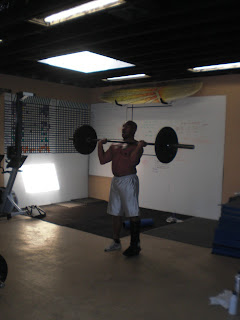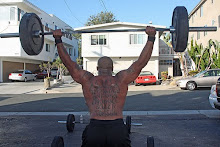
I’ve heard people say it takes too long to teach the full Olympic lifts correctly and that an Olympic lift with poor technique isn’t safe or effective. Well, I agree that poor technique in any lift isn’t very safe or effective for anyone. This is why we teach correct technique to our athletes from the beginning in anything we have them do. However, we need to remember that we’re dealing with athletes here. Is it really that hard to teach an athlete a very simple, quick precision movement? We can’t seem to teach them how to do a proper clean or snatch, but we can teach them how to do a proper deadlift? Or a proper front squat?
My understanding is that a deadlift done correctly closely parallels a clean pull, and the mechanical technique is largely the same. You want the athlete to have a rigid lumbar arch, a tight core, and loose arms, and the athlete should initiate the movement with the legs. The major difference here is that one movement is performed much more explosively than the other and with full hip and leg extension at the top of the lift. In addition, the deadlift is often performed with an alternating grip whereas pulls and cleans are performed with an overhand grip.
So which is the more athletic movement here, and which do you think might transfer more directly to an athletic event or game situation? If an athlete can learn how to rotationally spin and throw a shot put or learn the proper footwork and mechanics of a three-step drop pass, he can learn how to do a full clean or snatch in a shortened period of time. If we think otherwise, wouldn’t we be underestimating the ability of our athletes? Or maybe we just underestimate our ability to teach the lifts correctly? I think anyone who is seriously engaged in the strength and conditioning field should have some self-mastery of the Olympic lifts and should be able to correctly teach them and quickly see results in an athlete’s proficiency in performing them.
I’ve also heard people say that most athletes aren’t strong enough in the right places (posterior chain) or have the flexibility to execute the lifts properly. Well of course this would be true if they’ve never done the lifts before! That’s why we do them—to make them strong in the right places and develop flexibility. If your athlete couldn’t properly do an overhead squat, that would be a good indicator that he has weaknesses that need to be worked on. Some of the biggest causes of injury are inflexibility, joint immobility, muscle and connective tissue weakness, and muscle imbalances. The inability of your athlete to perform the full Olympic lifts is a good indicator that he is lacking in these areas. Your athletes will be far better off being able to perform the full Olympic lifts proficiently than avoiding them and trying to replace them with other lifts.
Some say the Olympic lifts put a lot of undue strain on the wrists, elbows, and shoulders. Again, this is probably true for an athlete who has never done the lifts before, and it’s a very good indicator that the athlete is lacking in necessary flexibility and joint mobility. For a younger athlete, the movement and positions of the Olympic lifts come naturally. For an older athlete, some discomfort is natural at first until the flexibility to do the movements is achieved. But any athlete would benefit from the flexibility and joint mobility it takes to do the lifts. If I had an athlete who couldn’t perform an overhead squat correctly, I would work with him until he could.
What about a college lineman or someone with a lot of upper body mass? Athletes like football linemen are already banging up their bodies on a daily basis. They don’t need to place more stress on their joints in the weight room. Really, the only time anybody puts undue stress on their joints and body in the weight room is when they lift too heavy or lift too heavy too often. Any type of lift done heavy and too often will lead to some kind of bodily breakdown or injury eventually. But volume, intensity, and training load aren’t something I wish to address in this article at this time.
Let’s take a look into the sport of weightlifting. At five foot eight, Serge Reding, the Belgium weightlifter, weighed close to 140 kilos with arms measuring 52 cm around. I don’t think there have been very many people to have walked this earth with as much mass packed on their frames as he had. And he had no problem hitting rock bottom to catch a snatch or clean. The list of large men who could proficiently do the full lifts include Russia’s Vasily Alexeev, America’s Shane Hamman, and Iran’s Hossein Rezazadeh.
Our own American heavyweight lifter, Shane Hamman, has a standing vertical jump of 36 inches and at five foot nine can dunk a basketball with two hands. He can also easily touch his toes and even do a standing back flip. How many college or NFL linemen can do that? So you can’t tell me that a football lineman wouldn’t benefit from being able to do the full Olympic lifts! And for that matter any athlete would be better off for having the ability to do them.
Another great reason for having an athlete do the full Olympic lifts is that they teach an athlete how to absorb impact, which we know is a huge part of any sport, particularly football (which is why football linemen should be doing the full Olympic lifts).
Muscle imbalances are a great cause of injury, something that should be avoided and should never happen as a result of weight room training. With the correct performance of the full Olympic lifts, there isn’t any chance for an athlete to develop muscle imbalances in the weight room. The Olympic lifts work an individual’s whole body through a full range of motion while both strengthening and stabilizing. Working partial movements such as partial box squats can set you up for muscle imbalances. The body was made to move through its full range of motion. While it’s detrimental to push beyond the normal range of motion, it’s also detrimental to chronically work in a restricted range of motion. Connective tissues shorten, improper firing sequences become ingrained, and strength imbalances develop. To develop optimal strength and mobility, full range training through the natural range of motion is best. The Olympic lifts provide this full effect.
In part one of this article series, we discussed that the physiological affects these lifts generate is far better than any attempt to duplicate them, so we don’t need to touch on those topics again. The Olympic lifts aren’t some intricate and complicated movement. They’re simple, precise, and athletic. Any athlete would benefit from their proper performance and use in a training program.
Injuries and other circumstances can lead to reasons for adaptation. We also lack greatly in qualified individuals to teach the lifts correctly in all levels of performance. Meg Ritchie Stone, throwing and coaching legend, says, “There are no dangerous lifts, only dangerous coaches.” But in an ideal world, these should be the lifts of choice for any athlete in any power sport.










